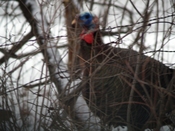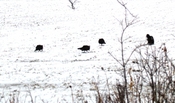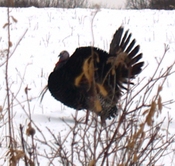 During the winter, turkeys assemble into three distinct groups; toms, jakes and hens. When spring arrives, these flocks start to break up and this is when the courtship and mating rituals begin. Mature toms will start to set up territories where they think they have the best chance to attract the most hens.
During the winter, turkeys assemble into three distinct groups; toms, jakes and hens. When spring arrives, these flocks start to break up and this is when the courtship and mating rituals begin. Mature toms will start to set up territories where they think they have the best chance to attract the most hens.
Over the last week, I got a chance to do some serious scouting for the upcoming spring turkey hunt. It’s truly an enjoyable time for me to be in the woods when there is no pressure to bag a tom and I get a chance to film and take pictures along the way. I like to spend numerous mornings in the woods trying to put the puzzle together on where the turkeys are spending the majority of their time.
Scouting also allows me the opportunity to learn the lay of the land. It’s extremely important to know the terrain of where you plan to hunt. Turkeys do not like to cross ravines, ditches, streams, fences or thick brush. Knowing where these obstacles are may make a huge difference come hunting time. You should also think about how you are going to move around the property. Premeditate your hunt. For example, if you see a tom strutted out in one particular field, how are you going to approach him without being detected? What is your game plan on where and how you would set up on him? Being prepared is important.
 I carry a map of the property with me at all times. I like to mark down where I think the turkeys are roosting, where they are feeding, breeding, strutting and their primary travel routes. This is my playbook and it will help me predict the turkey’s movements during the hunting season.
I carry a map of the property with me at all times. I like to mark down where I think the turkeys are roosting, where they are feeding, breeding, strutting and their primary travel routes. This is my playbook and it will help me predict the turkey’s movements during the hunting season.
Choosing where to set up on opening morning is always a difficult choice. Consistent scouting allows me to weigh the odds in my favor. Finding turkey sign to me is more important than actually seeing the turkeys in the field. I know if I come across tracks, droppings, feathers and scratching areas, I know most likely the turkeys will be visiting this area again. If I see a tom in the field, I’m happy, but where did he come from and where is he spending most of his time? Just because I saw him there two weeks ago, doesn’t mean he will be there again come hunting time. Consistent sign is a much better indicator!
When it comes to droppings, it’s important to understand what the difference is between a hen, a jake and a tom. A hen will leave a smaller pellet shaped dropping. A jake’s dropping will be larger than the hens, is most likely straight or somewhat hook shaped. A mature tom will leave a distinct "J" shaped dropping.
Turkey scratchings are also a good form of sign. Fresh turkey scratchings will have loose dirt around it. If the scratching was done in the leaves, most likely the leaves will be piled up. If the bottom of the leaves are still wet, this is a very fresh scratching.
 Finding out the main food sources is also important. Turkey’s diet consists of mast (fruit and nuts), seeds, insects and greens. Adult toms will eat ½ to 1 lb. of food daily and the majority of this is made up of plant matter. Look for agricultural fields or cultivated crops such as soybeans, corn, oats and alfalfa that are adjacent to roosting areas. Try to observe which fields are being hit at different times of the day.
Finding out the main food sources is also important. Turkey’s diet consists of mast (fruit and nuts), seeds, insects and greens. Adult toms will eat ½ to 1 lb. of food daily and the majority of this is made up of plant matter. Look for agricultural fields or cultivated crops such as soybeans, corn, oats and alfalfa that are adjacent to roosting areas. Try to observe which fields are being hit at different times of the day.
Scouting also allows me the opportunity to find out which tom is the dominant one. There are a few clues that can help you out. When viewing multiple toms in the field, the boss tom will have a tendency to strut more or longer than the other strutting toms. This is his way of showing his dominance. Also examine the tail fanning. The boss tom will most likely hold his tail fan fuller than the others. There is a pecking order and the dominant tom will run off the subordinate ones. The boss will also have a tendency to gobble first in the early morning and he usually gobbles more or will cut off the other toms that are gobbling. Hens can also give you clues and are most likely to communicate more with the boss tom. After you identify the boss tom, are there any characteristics that are unique about him? Does he have missing tail feathers, broken spur, odd coloring or a raspy gobble? This will help you recognize him come hunting time if he’s alone.
 Scouting also gives me the opportunity to test out various calls and see how the toms react to them. Anyone can master one call, but the key is to master many different calls within your arsenal. Scouting allows me to gain confidence by experimenting with each call.
Scouting also gives me the opportunity to test out various calls and see how the toms react to them. Anyone can master one call, but the key is to master many different calls within your arsenal. Scouting allows me to gain confidence by experimenting with each call.
Judging distances is very important when it comes to turkey hunting. While scouting, I plan out various ambush sites where I’m most likely to set up come hunting time. I will also take out my rangefinder and start marking distances in 10 yard increments. I’ve gone as far as driving stakes or tree branches into the ground. This is extremely important if you are trying to harvest a tom with your bow. I believe many toms are missed due to the fact that they were not as close as the hunter thought.
I believe scouting is the most important factor on why hunts turn out to be successful. Now is the time to get out there so that the odds will be more in your favor!
Some other scouting pics
Great info and pics grifter!!! I agree with you in the fact that pre season scouting is very important and great fun…no pressure! A hunting buddy of mine and I sat near a food source on Sat. afternoon attempting to see some toms…we saw none but did have 5 deer walk about 20 yrds from us as we sat on the ground up against some trees. I plan on going out this weekend hopefully I’ll have some pics to share..good luck this year…Jay
Nice read and great pictures Grifter! Those are some awesome shots with the snowy background! You have some dandy looking toms too…a couple of paintbrushes and one that looks like he has a double beard!
Those are some awesome shots with the snowy background! You have some dandy looking toms too…a couple of paintbrushes and one that looks like he has a double beard!  I’ll be out this weekend again to scout as well…next week can’t come fast enough!
I’ll be out this weekend again to scout as well…next week can’t come fast enough! 
You got my blood pumping



Great Scouting report Brad. Good Luck!
Great pics! Lots of useful info! Thanks for an early season refresher. Good luck on your hunts!
Definetly a great read! To bad I have to wait another 29 days.
Dt